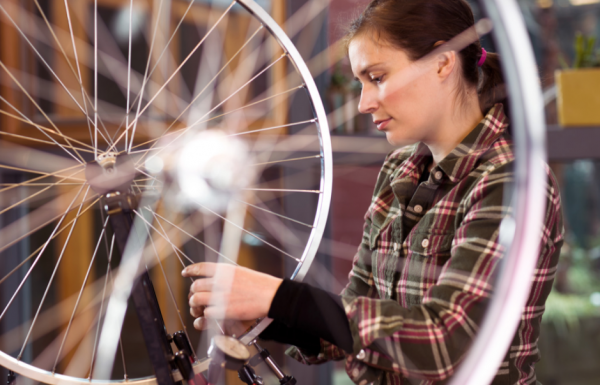10 Quick Bike Repairs for Common Problems
 Bike repairs are an inevitable part of life if you’re a regular cyclist. Some repairs can be costly and time-consuming, but not all problems require a trip to the shop. Here are ten common bicycle troubles that you can fix yourself with a few tools and some good know-how.
Bike repairs are an inevitable part of life if you’re a regular cyclist. Some repairs can be costly and time-consuming, but not all problems require a trip to the shop. Here are ten common bicycle troubles that you can fix yourself with a few tools and some good know-how.
1. Fix a flat
A flat tire is something that all cyclists encounter, which is why a bike pump and a spare tube should always be readily on hand. Flats are an easy fix if the tire is simply low on air. If the tube has been punctured, however, you have a little more work ahead of you. Watch this video on how to fix a flat tire.
The first thing you’ll have to do is remove the wheel from the frame. Most bikes are equipped with a quick release, but if you have an older bike, this might require some tools. Once the wheel has been removed, open the valve to let all the remaining air out, and then push the valve up into the tire. Remove the tire from the wheel rim and take out the inner tube. Check for any debris or what caused the puncture in the first place. Inflate the new tube just enough for it to hold shape and slip it back into the outer tire, then put the tire back onto the wheel rim and inflate it the rest of the way. The wheel is now ready to be placed back on the frame.
2. Recurring flat
If your tire keeps going flat, there’s something going on other than just bad luck. When you pull the tube out to replace it, make a note of where the hole is. If the tube is repeatedly being punctured along the top, the culprit is most likely an object stuck in the tire. If the hole is repeatedly occurring on the bottom of the tube, your rim strip might be out of position and the spokes may be to blame.
3. Recurring pinch flat
A pinch flat, also known as a snake bite, occurs when the tube is pinched between the tire and the rim and becomes punctured. A pinch flat has a distinct appearance. When you pull the tube out, there will be two holes on it that look, essentially, like a snake bite. If you are repeatedly getting pinch flats, it means that your tire pressure is too low. To fix this, put more air in your tires.
4. Slipped chain
Repairing a chain that has slipped off the cogset or chainring is quick and doesn’t require any tools. To put the chain back on, place it on the bottom groove of the rear cog, then slip it over the top of the front chainring. Turn the pedal forward carefully to pull the chain around the chainring and back onto the cogset.
5. Skipping chain
A chain that skips every so often is most likely harboring a tight link. You can find which link is causing the problem by backpedaling slowly while watching the rear derailleur. Once you find the skipping link, add some lube and gently work it back and forth until it’s loosened up.
6. Chain falls off repeatedly
Check to make your limiter screws on your derailleurs are set properly. Follow the instructions in these videos for you front derailleur and your rear derailleur.
If the limit screws do not fix the problem then a chain that’s too long will fall off and will therefore have to be shortened. To remove the extra links, you’ll need a chain tool. Using the chain tool, push the pin out of one of the links, being careful not to push it all the way out. Count out how many links you need to extract and use the chain tool to remove them. To reassemble your chain, line the ends up and use the chain tool to push the pin back into the links. Flex the reattached links to loosen them up.
7. Stuck seat
To fix a stuck seat, loosen the seatpost binder and soak the entire area in lube overnight. If the seat is still stuck and you’re unable to twist it free, you can increase the torque using pliers or an adjustable wrench.
8. Squeaky brakes
A squeaking noise when you brake usually signifies debris trapped on the brake pad. Clean the brake pads and the wheel rim with a simple acetone solution. If this doesn’t fix the situation, the debris may be embedded in the pad. You can attempt to clear it out by sanding the pads with 220-grit sandpaper, but if the squeaking continues, you might have to take the bike into the shop so they can test that the pads are toed-in.
9. Creaking wheels
Spokes are usually the cause of creaky wheels. It’s likely that a spoke might have come loose or that two spokes are rubbing against each other. Loose spokes can be tightened with a spoke wrench, but this is better left to a professional. If the noise is being caused by spokes moving against each other, lubricating the junction should eliminate it.
10. Creaking pedals
Creaking pedals usually signifies that the crankarm has come loose on the spindle. Remove the bolts on the crankarm and lubricate them, then tighten them to the recommended torque for your bike. Also remove your pedals and grease the threads.